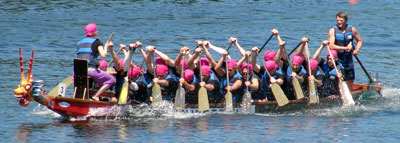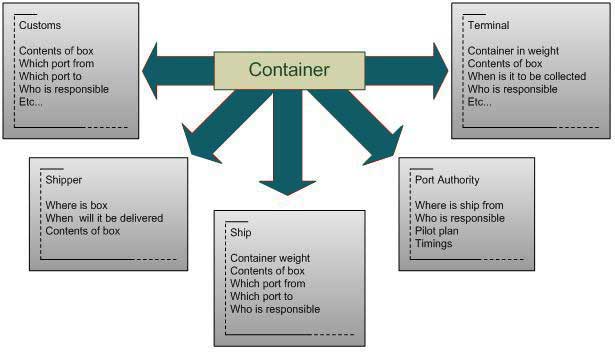| |
Issue 6 : October 2010 |
This is one very delayed newsletter!! The pressures of the work that pays the bills that make all the wheels go round. This should have been the May issue, and there were some witty comments on May Day; the capitalist’s nightmare or alternatively proof of capitalism red and raw with unions organising labour to be effective capitalists. The closed shop one of the more effective and enduring monopolies ever invented. Instead maybe I should discuss another nightmare, Halloween, but no, let us stick with the nightmare that is terrorism and our responses to it so at the end of this newsletter, a rather longer piece than usual on how can we secure our ports? DWA are in discussions related to a major new port security initiative and a few thoughts here are hopefully a precursor to more news next year. |
 |
Most of the delays in issuing the newsletter have been caused by working out how to fund port developments so a few more long term words on that are in order! A couple of new projects and a serious piece from Carolyn our new team member on team work, training and the softer side of management to round out this issue. As always it will be interesting to get your feedback on our opinions and comments in this newsletter, just contact me on [email protected].
|
Funding Infrastructure, Competition and the Circle of Life
 |
|
It is important to understand history to have an understanding of the anomalous position we are in at present related to the funding of large infrastructure projects. For hundreds of years up until the 20th Century, new infrastructure was built by individuals, companies or groups of “locals” who thought there were compelling reasons for them to build that bridge, road and later the canal or railway. Mostly these reasons involved profit and competition; the bridge that provided a town with the |
power to attract commercial traffic, the canal that enabled the creation of an industry or a railway that halved the transit time to London and increased the value of your land. Until the late 1870’s UK roads were almost exclusively built and operated in this way; the country also built and operated a network of canals and railways using similar models of motivation and finance. The UK was not alone, most of Europe and the US benefited from similar models to provide their infrastructure. Yet for fifty years it has been received wisdom that major infrastructure projects have to rely on governments for their inspiration and finance. Japan, Korea and China have in turn relied on large government investments to build world class infrastructure to underpin economic transformations. However Japan is rediscovering what canal and railway companies discovered by going bankrupt in previous generations; there is only so much infrastructure you can build and get a return on your investment. Bridges to nowhere do not count.
Taking us back into my favourite form of infrastructure, ports, the pendulum has swung swinging back over the last two decades away from government-led infrastructure development to private sector initiatives. After flirting with state owned monopolies in ports for fifty years, reforms centred on competition among private container terminal operators has led to stunning benefits:
 |
Port productivity and efficiency rising by up to 200% |
 |
The capacities of existing terminals increasing |
 |
Over time, costs per unit handled and in many cases actual charges falling |
 |
Ships spending less time in port, leading to lower freight rates |
| The opportunities have been spotted by more and more companies who are eager to invest in ever larger and longer term projects until we have today projects such as Maasvlakte 2 which has effectively been funded to the tune of € 3 billion from private sector sources. Bank lending is underpinned by a web of commitments from private sector developers including shipping lines and terminal operators. Such a project would have been considered impossible to finance in the private sector ten years ago, and yet today the |
|
 |
government through the Port of Rotterdam has as its main role management, coordination and approval, and not design and construction. In Australia, private sector funding of projects is perhaps reverting even closer to the motivation and structures of the past. The existing port facilities of Rio Tinto, Dalrymple Bay Coal Terminal and in Newcastle and numerous proposed port projects on the coast of Queensland and in Western Australia prove the potential for private sector infrastructure valued in the US$ billions.
To finish this leaves us two questions:
- In the long term, what is the proper role for government in large infrastructure projects? Inspiration of finance?
- How should private companies look at major investment in port infrastructure? What makes a large, long term investment worth it?
The first of these I would welcome your comments on; the second I am speaking on at a conference in early 2011, so no doubt I shall say more in subsequent issues of this newsletter.
Iraq, Umm Qasr
DWA has been venturing out with another contract in the Middle East; this time in Iraq. Developing an understanding of the market potential and looking into the services offerings a container freight station in the Port of Umm Qasr should make and to whom. This led onto the development of proposals that should lead to a very real development in difficult circumstances. The next stages of this one could prove most interesting and provide opportunities for exciting travel for those involved!
Crewing Your Boat
 |
|
Most of us have a vision of great leadership. Winston Churchill, Ghandi and Mandela often feature in people’s list of the greatest leaders of them all. In business there seems to be a steady stream of high profile Chief Executive aspiring to be |
that great leader whose presence and strategy changes “their” company. Such leaders do not encourage enduring greatness, they initiate change but the company can lose momentum if they leave or if the crew are not working towards the same vision. Everyone needs to be on board and striving for the same goal.
Studies show that the most effective leaders are not the big brash types but those who focus on building their crew and ensuring that the right crewmembers are focusing on the right jobs. After that they are ensuring the crew share a common vision. Put biblically they are trying to ensure that all the parts of the body work together for the common aim.
So how can a leader most quickly learn the abilities and styles of the members of their team to ensure they are engaged most effectively? How can team members learn to understand the strengths and weaknesses of their compatriots especially when most of the answers are entwined with their personalities?
To some the idea that apparently simple questions can derive deep insight into your understanding of the world, your attitudes and the way you make decisions is absurd. They should perhaps experience the process before coming to judgment. One well researched approach to team building is to look at your team through their personalities. Recognised instruments and systems such as Myers Briggs Type Indicators (MBTI) and Human Dynamics provide insight into innate personality preferences. Understanding and interpreting these in the context of the team provide a powerful tool to understand and then strengthen the team. Our recent work in port management teams has provided adequate evidence of the power of such team building. To recognise how introverted the thinking of a marketing team was for example or exposing how few of those in strategy development were uninterested in deep analytical understanding was to say the least revealing and a helpful tool to identify weaknesses that can be addressed. The benefits that can be derived by any leader from understanding the preferences and likely dynamics of themselves as well as their team can be immense. However professionalism and understanding the limitations of the methods can be critical. They are only a part of ensuring your crew are on board and navigating to the same destination.
In the long run there is one final bonus from this “personality” approach to team building. The self understanding it gives to you and each member of the team. To known your own motivation, methods and personality in many cases provides substantial return on any investment made. To learn more or try it out, contact Carolyn at [email protected]
Oil Products Market Study
The company has recently undertaken an interesting study of the potential for the development of 3rd party tank terminals for oil products in Indonesia. It was fascinating to understand the differential rates of growth in consumption in different product groups; witness the move away from kerosene stoves to gas or electrical cooking in the statistics and forecast the impact these changes will have on the balance and mixture of the total oil product consumption. More interestingly was the scale of need for product storage and distribution across the archipelago.
Security
To be secure is to be: free from fear, anxiety or doubt, free from danger or attack, not likely to fail, reliable and dependable. To deliver freedom from fear requires the development of faith, confidence and trust that your systems can consistently deliver the promise of security. Asymmetric warfare; the irrational acts of terrorists has brought into question in everyone’s mind the ability of any level of security to truly deliver freedom from fear. Steps towards deterrence of attacks can remind people of the threats that motivate the deterrence and steps to offer physical security. Is this a Catch 22 or a reminder that to deliver security to users and stakeholders requires a far more holistic view than we have at present offered or delivered? Or do we need to integrate security thinking into our life process; make it part of our business process in the way that safety should be?
Standard forms of security view everyone as a threat until proved otherwise. Operations management requires constant confirmation that activities are being undertaken as expected and promised. In one view you must constantly prove you are permitted to do what you wish to do. In the other you must continue to do what you should be doing. These statements should be mutually supportive. If you are doing what you should be doing you are not a threat. Alternatively, anyone doing things they should not be doing is a threat to your security be that your company’s performance or a more tangible threat to everyone.
A security analyst will say, “to fully protect the port, we need to keep ahead of potential threats and identify attacks that can cause critical systems damage”. An operations manager will say, “to ensure the port operates effectively at all times we need to ensure everyone is doing what they should be doing at all times”. To be secure is to be operationally effective. Security should work closely with all port tenants (liner operators, terminal operators) to understand how people should be operating, what people, equipment and cargo should be doing. When activity is being monitored and it no longer is doing that which is expected there is a threat, operational or security which needs to be resolved.
The boundaries of the shippers, shipping companies, terminals, stevedores, port tenants, port users and stakeholders within which their security needs to be maintained intersect at ports.

Start your consideration by thinking about a container. Treating it in a simplistic way makes it easy to see the information overlaps between different port users and stakeholders. Operational information is sometimes shared between stakeholders for mutual benefit. But how often is the same information interpreted and understood for its security implications?
Look again from the perspective of the container and the potential threats to that container. It can be placed next to the wrong commodity in another container. Someone can try and steal the contents. Someone can overload the container. It can be poorly secured. Someone can try and use it to smuggle; people, bomb-making equipment or worse. Control and management of the container is similar for all those concerned with that container. The information flow about that container though has multiple strands and a complex web of who knows what. The security of the container is best served by an analysis of all information to identify the exceptions and the extent of those exceptions (also known as “threats”).
When you understand that this approach can be repeated over all aspects of port operation and management, and in almost all assessments undertaken you get similar results, you start to see why convergence of systemic operations and security provision is inevitable. In ports this brings us to Operational Space Control (OSC); an advanced way of thinking about convergence and ensuring the security of critical infrastructure, the business it supports, an open society dependent upon the free flow of commerce generated by the infrastructure.
An Operational Space refers to the area or volume inside the perimeter of influence or reach associated with the domain. The security limits of a port for example and the maximum distance from which a threat may come or be detected as incoming. OSC is the notion that full and comprehensive security requires an understanding of the activity within that space and then understanding when activity is occurring that breaches any form of logic or reason for an acceptable operation. Having detected the breach remedial measures can be taken, operational or security, and graduated between the two as the “threat” develops. OSC enhances the ability of managers to identify and react to any threat be that to effective operation or in extremist criminal and terror activity.
Implementing OSC will require negotiation of access to a wide range of systems and data. This will then need to be supported by the definition of complex operational procedures and parameters. Applied properly it will offer real security for ports. Watch future issues to understand how such systems are developing and our involvement!
|